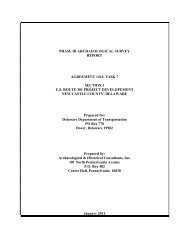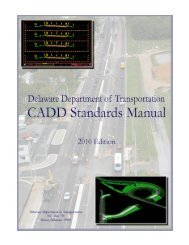Gulph Creek Stone Arch Bridge - Delaware Department of ...
Gulph Creek Stone Arch Bridge - Delaware Department of ...
Gulph Creek Stone Arch Bridge - Delaware Department of ...
You also want an ePaper? Increase the reach of your titles
YUMPU automatically turns print PDFs into web optimized ePapers that Google loves.
Chapter 3—Historic Context for Common Historic <strong>Bridge</strong> Types<br />
County, Minnesota, was the longest concrete arch bridge in the world when it opened in<br />
1926. Designed by Turner and Walter H. Wheeler, it originally consisted <strong>of</strong> 13 openspandrel<br />
concrete arches, each supporting a flat-slab deck. Although this structure was<br />
probably the longest bridge in the world using a flat-slab system, it was not a flat-slab<br />
bridge. Unfortunately, the Turner-designed deck <strong>of</strong> this NRHP-listed bridge was<br />
replaced by a more modern system, thus destroying that aspect <strong>of</strong> its design most<br />
associated with Turner.<br />
Most <strong>of</strong> the earliest flat-slab bridges were simple spans <strong>of</strong> no more than 30 feet in<br />
length, and usually less than 20 feet, in which the horizontal slab <strong>of</strong> square or rectangular<br />
shape rests on abutments or piers. When kept short, these bridges proved to be<br />
economical and easy to erect. But continuous, multi-span, flat-slab bridges were also<br />
built from the 1910s through the early 1940s, even though each incremental increase in<br />
the slab’s length also required an increase in its depth or thickness, thus adding to its<br />
structural weight. The need for supporting piers tended to increase the cost and<br />
impracticality <strong>of</strong> the flat-slab bridge, at least compared to the T-beam bridge, with which<br />
it had to increasingly compete for the favor <strong>of</strong> state and county engineers.<br />
Significance Assessment: A number <strong>of</strong> pre-1955 slab bridges remain, many<br />
because they have thick slabs and are <strong>of</strong>ten located in rural areas not subject to roadway<br />
salting. Pre-1955 concrete slabs possess significance within the context <strong>of</strong> this study if<br />
these are intact. The most significant types <strong>of</strong> slab bridges are those that retain integrity<br />
and that can be identified as having been built according to the standard plans <strong>of</strong> the<br />
transportation departments in the first quarter <strong>of</strong> the twentieth century and particularly,<br />
those that were built very early in this type’s history—within the first decade <strong>of</strong> the<br />
twentieth century. The scenic qualities <strong>of</strong> these some slab bridges, such as those that are<br />
intact and retain their original concrete rails, can elevate their significance within the slab<br />
category. Character-defining features include the slab, parapet or railing, and abutments,<br />
wingwalls and, occasionally piers.<br />
Examples <strong>of</strong> Reinforced Concrete Cast-in-Place Slabs<br />
1. Dry <strong>Creek</strong> <strong>Bridge</strong> (1929), Pierce County, WA. NRHP listed 1997 in Mt.<br />
Rainier National Park MPS.<br />
2. Chester County <strong>Bridge</strong> No. 225 (1907), spanning Tweed <strong>Creek</strong> at<br />
Hopewell Road, Oxford vicinity, Chester County, PA. HAER PA-415.<br />
3. Coop <strong>Creek</strong> <strong>Bridge</strong> (1940), Broadway Street (CR 236), Sebastian County,<br />
AR. NRHP listed 1995.<br />
4. Hartford Road <strong>Bridge</strong> (1943), over branch <strong>of</strong> West <strong>Creek</strong> on Hartford<br />
Road (CR 5), Sebastian County, Arkansas. NRHP listed 1995.<br />
5. Jacks Canyon <strong>Bridge</strong> (1913). NRHP listed in 1988 in Vehicular <strong>Bridge</strong>s<br />
<strong>of</strong> Arizona MPS.<br />
6. Ramsey Park Swayback <strong>Bridge</strong> (1938), Redwood County, MN. Listed in<br />
http://www.mnhs.org/places/nationalregister/bridges/bridtype.html,<br />
Minnesota’s Historic <strong>Bridge</strong>s By Type.<br />
3-85






